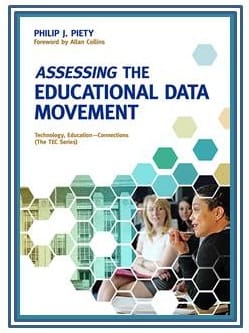 When it comes to using data for education policy and reform, two factions emerge: modern Luddites who fear the mechanization of schooling and tech-savvy number crunchers who tend to believe that data will solve all of education’s woes. This book by IT pro Philip Piety deftly weaves between the factions and offers a valuable read for teachers, administrators, and policymakers looking to work productively with educational data without becoming overwhelmed. Piety divides it into three sections. The first lays out the history of the educational-data “movement” and the current debate surrounding value-added measures and testing. The second discusses best practices in and applications of administrative infrastructures—which include data systems about teaching methods and students. For example, the U.S. Department of Education’s State Longitudinal Data Systems (SLDS) program created a powerful research tool and a nexus of information crucial to federal, state, and local policy goals. The third examines how data can be helpful to the “technical core”—that is, students, teachers, materials, and classrooms. Even more helpful, the author showcases how Teach For America and KIPP use metrics innovatively to, among other things, improve instruction.
When it comes to using data for education policy and reform, two factions emerge: modern Luddites who fear the mechanization of schooling and tech-savvy number crunchers who tend to believe that data will solve all of education’s woes. This book by IT pro Philip Piety deftly weaves between the factions and offers a valuable read for teachers, administrators, and policymakers looking to work productively with educational data without becoming overwhelmed. Piety divides it into three sections. The first lays out the history of the educational-data “movement” and the current debate surrounding value-added measures and testing. The second discusses best practices in and applications of administrative infrastructures—which include data systems about teaching methods and students. For example, the U.S. Department of Education’s State Longitudinal Data Systems (SLDS) program created a powerful research tool and a nexus of information crucial to federal, state, and local policy goals. The third examines how data can be helpful to the “technical core”—that is, students, teachers, materials, and classrooms. Even more helpful, the author showcases how Teach For America and KIPP use metrics innovatively to, among other things, improve instruction.
SOURCE: Philip J. Piety, Assessing the Educational Data Movement (New York, NY: Teachers College, Colombia University, 2013).
